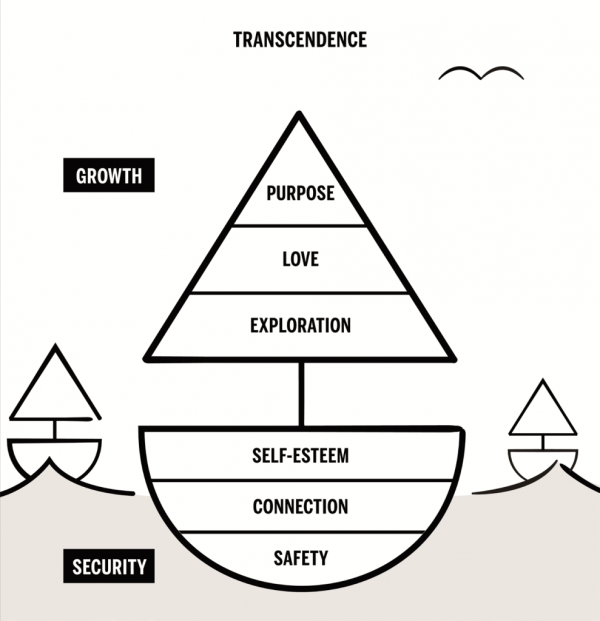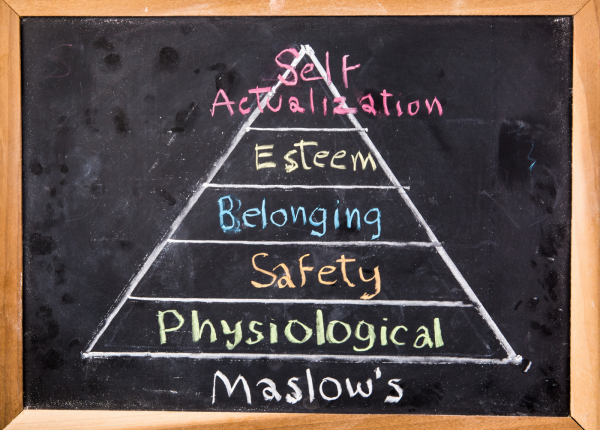n the 1940’s the german neurologist, Kurt Goldstein coined the term Self-actualization which can be understood as the process of realizing one’s full potential. This term is more frequently associated with humanistic psychologist Abraham Maslow. Maslow is best known for his work on the human hierarchy of needs. You may have seen the human hierarchy of needs pyramid which is often attributed to Maslow but was actually created by a management consultant in the 60’s. The pyramid was a simplistic interpretation of Maslow’s work which made it seem that we reach needs in a linear manner. It turns out that humans are constantly alternating from meeting lower to higher needs. The Self-actualization process is less like climbing a mountain and more like surfing waves.
In his book “Transcend: The New Science of Self-Actualization” psychologist Scott Barry Kaufman builds on Maslow’s work to present us with a new metaphor for Self Actualization. Kaufman proposes an image of a sailboat with the boat’s base representing deficiency needs and the sail representing growth needs. Deficiency needs are marked by dissatisfaction due to a lack of self-esteem, connection, and or safety. When we don’t meet these basic needs we are more likely to use defense mechanisms to protect ourselves. We all experience moments of insecurity that cause us to close down. But we also have moments where we feel secure enough to open our sail. In these moments we work towards fulfilling the growth needs of purpose, love, and exploration. Each person is constantly alternating between closing down and opening-up but the longer we can stay open the more we can grow. In this article, we will examine both the barriers and pathways towards Self-Actualization.

Safety
For us to grow we must meet our most basic need of safety. Safety from the physiological standpoint is making sure we are getting enough food, water, movement, and rest. When we don’t meet our physiological needs our bodies and minds function in suboptimal ways. Hunger is the easiest of the physiological needs to recognize. The hungrier we become the more we want to eat and the less we want to do anything else. Our need for sleep works in a similar way although it is easily masked. Many people are chronically sleep-deprived and don’t know it because they use caffeine to mitigate the effect. Getting adequate nutrition and sleep is our body’s priority; exercise follows close behind. Exercise releases endorphins (natural pain killers) in the brain that help combat stress. A lack of movement or exercise can both create and contribute to physical and mental health issues. Meeting the physiological needs is the simplest part of safety yet many people neglect this aspect creating a major barrier towards self-actualization.
Attachment styles
From a psychological standpoint, safety is about how we orient ourselves to the world. Humans are social animals so much of what we deem to be the world is other people. To understand how we orient to other people it is helpful to understand attachment theory. Developed by psychologist John Bowlby attachment theory states that how we relate to others is greatly impacted by our relationship with our earliest caregiver. In times of stress, infants look to their caregivers to provide safety and reassurance. Depending on these early interactions humans will develop one of the following four attachment patterns.
1.Secure – Infants whose parents were highly attuned and responsive to their needs tend to develop secure attachment. Secure attachment is marked by a positive view of self and others. Adults with this attachment pattern find it easy to become emotionally close to others. They are comfortable depending on others and having others depend on them. They rarely worry about being alone or not being accepted by others.
2.Anxious-preoccuiped – Infants whose parents provided unpredictably responsive caregiving tend to develop anxious-preoccupied attachment. Anxious-preoccupied attachment is marked by a negative view of the self and a positive view of others. Adults with this attachment pattern want to be completely emotionally intimate with others but find that others are reluctant to get as close as they like. They are uncomfortable being without close relationships and worry that others don’t value them as much as they value others.
3.Dismissive-avoidant – Infants whose parents are frequently unattuned and unresponsive to their needs will develop dismissive-avoidant attachment. Dismissive-avoidant attachment is marked by a positive view of the self and a negative view of others. Adults with this attachment pattern are comfortable without close emotional relationships. It is important for them to feel independent and self sufficient. They prefer not to depend on others or have others depend on them.
4.Fearful-avoidant – Infants who experience abuse and trauma tend to develop fearful-avoidant attachment. Fearful-avoidant attachment is marked by an unstable and fluctuating view of self and others. Adults with this attachment pattern are somewhat uncomfortable getting close to others. They want emotionally close relationships but find it hard to trust others. They worry that if they allow themselves to become too close to others they may be hurt.
While each person has one predominant attachment style none of us maps perfectly onto these patterns. No one is completely securely attached; all of us can become anxious or avoidant in stressful situations. Understanding attachment theory can help us identify our predominant attachment pattern and work toward creating a healthier one. Both anxious and avoidant patterns can be barriers on our path towards self-actualization.
Meaning
Beyond our physiological needs and our orientation towards others what is most important to establishing a secure base is our ability to generate meaning. In order to generate meaning we have to establish 3 aspects of it.
1.Coherenece which is our ability to make sense of our immediate environment.
2.Mattering which is the feeling that our actions are valuable to the world.
3.Purpose which is the motivation to realize future goals.
Our minds naturally seek to generate meaning but in times of great uncertainty our ability to find meaning dissolves. Uncertainty is a part of life but too much of it can be disorienting and overwhelming. The ability to handle uncertainty varies from person to person. Those who score high in the personality trait of neuroticism have a harder time dealing with uncertainty. As our perceived uncertainty increases we use more metabolic resources and experience more stress. Notice the word perceived as what is most important for our feeling of safety is the perception of certainty and control. The majority of us generate this perception of certainty easily and feel safe in most situations. But those with unprocessed traumas may feel that they are constantly under threat and struggle to establish safety.
Trauma
Trauma is the experience of an event that causes a person emotional distress beyond their ability to cope or understand. It can result from violence, sexual or emotional abuse, accidents and loss. Those with unprocessed traumas superimpose their trauma on everything around them making it difficult to decipher the present from the past. Traumatic memories can be triggered by external stimuli causing the victim’s body to mirror their physiology at the time of the trauma. Some traumatized people are too hypervigilant to enjoy ordinary pleasures of life while others become too numb to absorb new experiences. Being able to feel safe with others is one of the most important aspects of mental health. Yet traumatized people often find themselves out of sync; struggling to establish safety. Healing ourselves from any unprocessed trauma is crucial for establishing safety and moving towards fulfilling our need for connection.
Connection
True connection is paradoxical because it requires both bonding over commonalities and acceptance despite differences. We cannot establish relationships without common ground but nor can we grow them without new perspectives. When we fulfill our need for connection we feel accepted as we are and inspired to grow in our own authentic way. High-quality connections naturally activate our brain’s opioid system relieving pain and making life more pleasurable. When we lack meaningful connections we experience loneliness which has been shown to be more hazardous to our health than smoking cigarettes. It is no wonder that there is a direct correlation between the lack of high-quality connections and increasing suicide rates. Social media may have connected us to more people but it has also diminished the meaningfulness of those connections. When it comes to fulfilling our need for connection it is important to focus on the quality and not the quantity of our relationships.
Self-Esteem
The final security need we look to fulfill is that of self-esteem. Self-esteem includes self-worth and mastery. Self-worth is our perceived value of ourselves while mastery refers to our ability to achieve our intended goals. Self-worth & mastery tend to develop together, although we are capable of having one without the other. For example, you can feel good about yourself but not be very effective at achieving your goals. Or you can be highly effective at accomplishing your goals without actually respecting yourself. Our self-worth is directly related to our social value which we measure by our perception of how valuable our relationships are with others and how valuable others perceive us to be. Our perceptions can become distorted causing us to perceive ourselves as less or more valuable to the world. Those that are overly praised or condemned as children may develop NPD (narcissistic personality disorder) which can be understood as excessive self-esteem. The irony of self-esteem is the less we focus on it the more likely we are to feel worthy and competent.
Moving towards Growth

Exploration
When we meet our security needs we feel confident enough to open our sail and pursue the fulfillment of our growth needs. The first growth need is exploration which is the desire to seek out and make sense of novel information and experiences. Exploration can further be broken down into 5 sub needs of social exploration, adventure-seeking, posttraumatic growth, openness to experience, and intellect. Social exploration is our curiosity for knowing and understanding other people. Adventure-seeking is our willingness to undergo risks in exchange for new and exciting experiences. Post-traumatic growth is the positive psychological change we create by struggling with challenging life situations. The sub needs of openness to experience and intellect are a part of cognitive exploration. Openness to experience is our willingness to engage with unfamiliar information and experiences. Intellect is the need to know and understand. Fulfilling our need for exploration requires us to overcome our fear of uncertainty and stepping into the unknown.
Love
The next growth need we look to fulfill is that of love. While our need for connection is more about receiving love, love from the growth perspective is about giving love. Before we can love another it is vital that we love ourselves. When we meet our security needs we have a solid foundation for self-love and a natural drive to love others. We are able to set healthy boundaries and balance our needs with the needs of others. We have different ideas of love but the highest and most mature form of love is free of clinging or attachment. This is a love that lets stay and lets go. Both anxious and avoidant attachment styles can be barriers to embodying this kind of love. While anxiously attached individuals cling and avoidant individuals strive to maintain complete individuality, those with secure attachment can both merge with another and retain their uniqueness.
Purpose
The growth need that ties our self-actualization journey together is purpose. Purpose is the need for an overarching principle or mission to guide our lives. Purpose can be the most difficult need to fulfill because it takes a deep understanding of who one is as a person. One of the biggest misconceptions we hold of ourselves is that we are one stable solid entity. In fact, every person is a subset of identities and roles. Different parts of us want different things and this can become problematic. When our identities aren’t well integrated they clash and cause us to experience inner conflicts. We chase two rabbits at the same time and catch neither. It is helpful to have a future vision of our highest self and to connect our goals to actualizing that vision. Our purpose is to become that person we envision and every other goal is a stepping stone towards making that a reality.
Transcendence
Self-actualization is not a final destination but a process that is underway when both our security and growth needs are being met. To consistently fulfill the 6 needs of safety, connection, self-esteem, exploration, love and purpose is the mark of a very rare accomplishment. Yet there is one final human need that typically only arises in highly self-actualized individuals; the need for transcendence.
Self-actualizers that are driven to fulfill their need for transcendence are often fueled by transcendent or peak experiences. Peak experiences are categorized by a quieting of the ego and increased feelings of interconnectedness. These experiences differ in intensity but often result in the disorientation of space and time, inhibition of fears, greater acceptance of oneself and others and a merging of self with all that is. Peak experiences can arise in a variety of contexts, tend to be spontaneous but can sometimes be consciously stimulated. For example, one person may have a peak experience while walking in nature, another in a near-death scenario, and a third while taking a psychedelic substance.
Peak experiences are temporary states but they can lead to permanent changes. Meditators work diligently to elicit these states until their brains are permanently rewired. Transcendence or awakening is a permanent change of our experience of ourselves from a skin-encapsulated ego to unity-consciousness or non-dual awareness.
Conclusion
Self-Actualization is the process of realizing one’s full potential. A human moves towards Self-Actualization by fulfilling both their deficiency and growth needs. The deficiency needs include safety, connection and self esteem. When these needs are not being met a person closes down and is unable to move towards growth. When our deficiency needs are met we can open up and work towards fulfilling the growth needs of exploration, love and purpose. The Self-Actualization journey is never complete because there is an endless amount of ways that a human can grow. Still, one can be considered to be a Self-actualizing individual when they are consistently meeting all 6 needs of safety, connection, self-esteem, exploration, love and purpose. A small percentage of Self-actualizers will look to fulfill one final need; the need of transcendence. Fueled by peak experiences, these Self-actualizers look to transcend the ego and merge with all that is.
Author: Artem Zen


